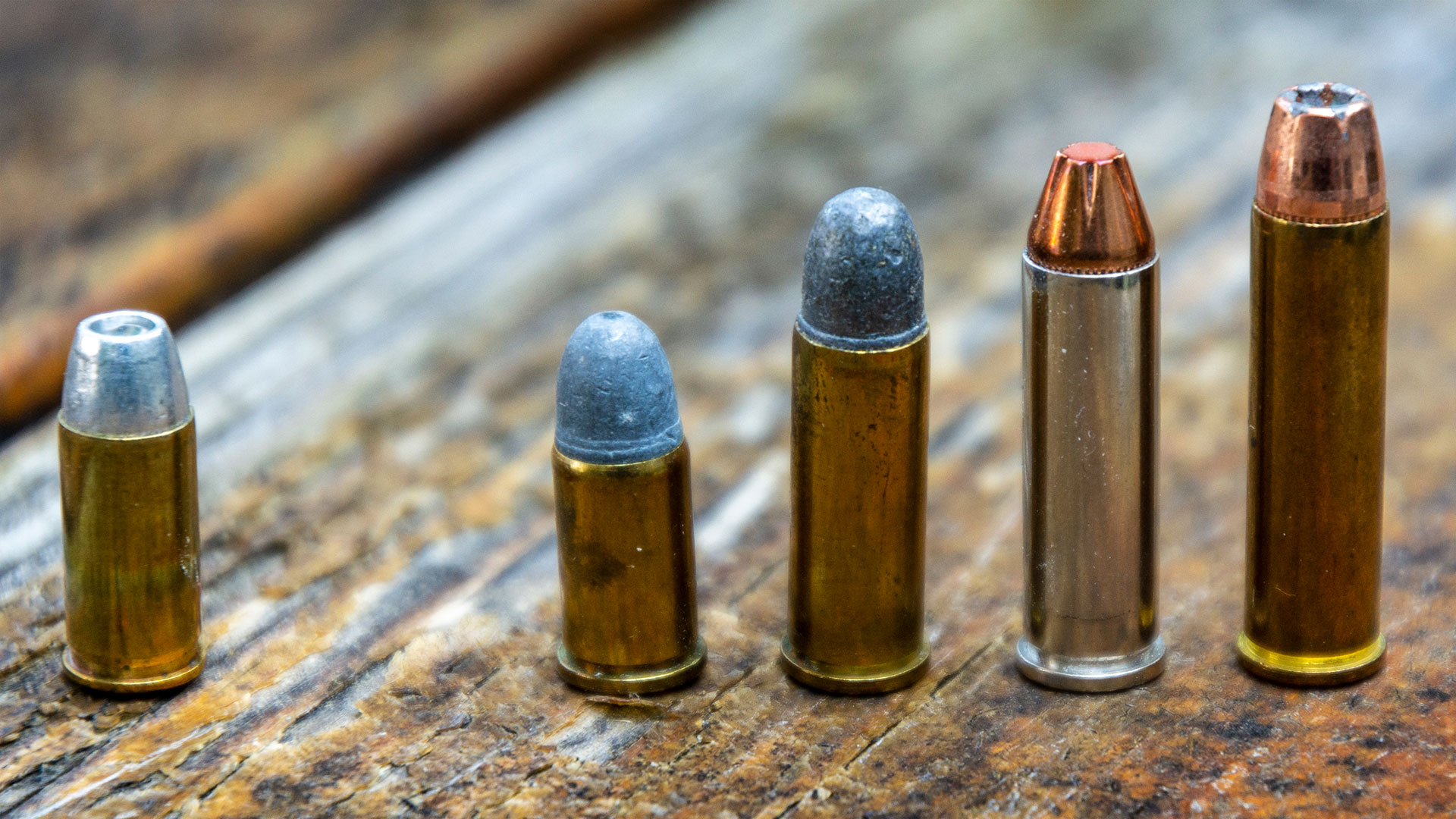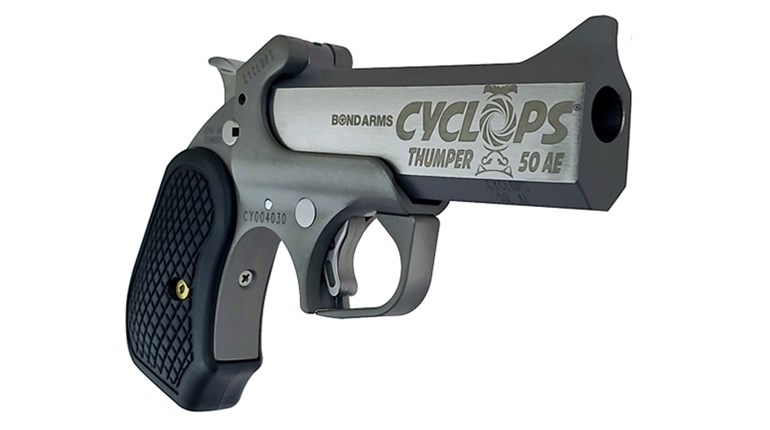
Among the first commercially successful repeating handguns sold in the U.S. were Colt’s Pocket Models. As can be surmised from their name, these late-1840s percussion revolvers, throwing .320-inch-diameter lead balls, were small enough to conceal in a pocket. In 1861, when Smith & Wesson added a second model to their lineup to complement their original, revolutionary cartridge-firing tip-up .22, the new revolver was chambered in .32 Rimfire.
After the Civil War, Smith & Wesson offered new top-break revolvers featuring the new cutting-edge centerfire technology, and one of the first was the little .32 Single Action. The new cartridge, dubbed the .32 Smith & Wesson, threw an 85 grain .312-inch-diameter bullet at almost 700 fps.
Twenty-some years later, when Smith offered their new solid-frame revolvers with swing-out cylinders and manually-operated ejector rods, the new Hand Ejectors were initially chambered in a lengthened version of the same cartridge. This new .32 Smith & Wesson Long propelled a heavier 95-grain bullet of the same .312-inch diameter a good 100 fps faster. The lengthened cartridge case kept people from stuffing them in old top-break guns with the resulting explosive consequences.
In its early heyday, the .32 S&W Long was considered a perfectly adequate law enforcement cartridge. In fact, Colt offered the .32 Colt New Police chambering, which was the exact same cartridge, albeit with a flat-point, 100-grain bullet for better terminal performance. While it was the dominant cartridge in small revolvers for the first half of the 20th Century, though, it started to be supplanted by .38 Special small frame revolvers.
In the 1980s, gunmaker Harrington & Richardson teamed with Federal to release a “magnum-ized” version. Sticking with the same .312-inch-diameter bullet and lengthening the case again created the .32 H&R Magnum; a great idea, but one whose potential was limited by the need to be safe to fire in the somewhat fragile old H&R revolvers.

The ultimate iteration of the .312-inch-diameter revolver cartridge (thus far) appeared on the market in 2008. With the launch of the new .327 Federal Magnum came a cartridge that equaled the terminal ballistics of 125-grain, standard-velocity .357 Magnum loads, with the upside that you could fit six of them in a small frame revolver like the Ruger SP101 or the Smith & Wesson J-frame or…
Hey, check out this Taurus Model 327 snubbie!
Testing The Taurus Model 327
The .327 Federal Magnum is a cartridge that was practically made for this Taurus. When Taurus slightly upsized the five-shot Model 85 into the Model 856 six-shooter a few years ago, the thin chamber walls of the new cylinder meant there wouldn’t ever be a .357 Magnum version of the new wheelgun; there just wasn’t enough metal there to handle those stresses. But six charge holes for smaller-diameter .312-inch diameter cartridges left ample meat between chambers, even for the stout 45,000 psi chamber pressures of .327 Federal Magnum.
Similarly, while Smith & Wesson has chambered its J-frame for .32 H&R Magnum in the past, there’s just not enough metal in the J-frame cylinder to accommodate six charge holes and still resist the .327 Federal Magnum’s forces, and a five-shot .327 J-frame would, realistically, never sell when the same revo could be had with a five-shot .357 Magnum cylinder.
Let’s get hands-on with the test gun from Taurus USA, shall we?
From the side, the review sample looks like yet another Model 856 two-inch snubbie, matte black finish (well, Taurus calls it “Matte Black”, but it’s really more of a matte dark gray) applied to a frame, cylinder, and barrel constructed of stainless steel. Unless one notes the model designation on the frame, there’s not really anything to give away the fact that this thing’s a good bit sportier than the typical shorty .38 Special.
And sportier it is, because the .327 Federal Magnum for which the Taurus Model 327 is chambered is spicier than any .38 Special +P loading that its Model 856 cousin will handle. As an added bonus, heavier .32 H&R Magnum loadings from boutique ammunition manufacturers that are bordering on the dreaded “brisk but manageable” in my Smith & Wesson 432PD Airweight are absolutely controllable in the steel-framed Taurus 327.
This is significant, because while good .32 H&R Magnum loadings have ballistic performance that’s entirely adequate, the .327 Federal Magnum is, in the best jacketed hollowpoint loads like the 115-grain CCI Gold Dot, as good a personal defense round as you can get in a small-frame revolver. It was essentially designed to mimic the terminal performance of rounds like the 9mm 124-grain +P and the midrange .357 Magnum 125-grain, both of which are benchmark personal defense loads.

I’ve put several hundred rounds of ammunition through the Model 327 test gun, ranging from soft-shooting 98-grain .32 Smith & Wesson Long target wadcutters to romping, stomping .327 Federal Magnum Gold Dots, and I have to say that the little wheelgun has delivered. It has never hesitated to bust a cap, whether with soft Federal primers in domestic loads or the harder-than-woodpecker-lips primers in Fiocchi or Sellier & Bellot imports.
The Taurus Model 327 shoots pretty much right to point-of-aim at 7 yards with rounds operating at greater-than 1,000 fps velocities of .32 H&R or .327 Fed, but that’s to be expected.
Personally I prefer hot .32 H&R Magnums (I currently have Ventura Munitions 100-grain LSWC in the gun, which has been on my belt for several months now) because they have absolutely adequate terminal performance without the need for me to haul the sights back down out of recoil between shots, but if you have the wrists to keep the .327 Federal Magnum Gold Dots on target, this would be a great little package from which to launch them.
Parting Shots
MSRP from Taurus for the Model 327 is under four bills, and the only other small-frame revolver chambered in .327 Federal Magnum with similar capabilities on the market right now is Ruger’s LCR, which stickers for… well, let’s say you could buy rather a large amount of ammunition for the difference in their sticker prices.
If you want a small-frame, hard-hitting six-shooter with a reasonable price tag, you could do a lot worse than the Taurus 327, and you’d have a hard time doing much better. About the only thing that could make this thing hew more closely to my platonic ideal of a belt-carry CCW revolver would be a three-inch barrel and an alloy frame.
Taurus Model 327 Specifications
- Manufacturer: Taurus
- Model: Taurus 327
- Action: DA/SA Revolver
- Caliber: .327 Federal Magnum
- Height: 4.8 inches
- Width: 1.41 inches
- Length: 6.55 inches
- Barrel Length: 2 inches
- Weight: 22 ounces unloaded
- Twist: 1:18.75, Right hand
- Finish: Matte black
- Capacity: Six rounds
MSRP for the Taurus Model 327 is $389.99, and more information on this gun is available at taurususa.com.



































